 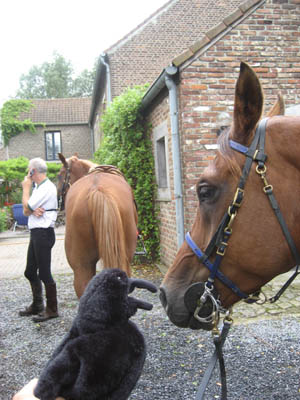    | Sunday July 22 2007 Friendly people, beautiful countryside, thick green wet forests, old well-preserved houses and castles, perfect lighting, not least the mild weather... Belgium has grown on me and the Raven quickly. Leonard and Carole live in a little village, Gesves (say “zhev”) 70 km from Brussels, putting them in the southern region of Belgium, the Wallonian French-speaking part. Leo's lovely old house probably originally dates back to the 1800's – he's lived in it for 10 years. There's a few old stables and several paddocks rich with grass for his 4 horses. Many of the village dwellers rebuild the houses from the 1700's and 1800's in the old stone style. Many were big old farmhouses, half of which the family lived in and half which was the stables for the animals. Belgium has more castles per square mile than any country, and I saw a number of them driving to Leo's house from Brussels (“Oh, there's another castle”). Most people keep up their old places in meticulous condition, taking much pride in landscaping them. Brilliant, bright-colored flowers inhabit many brick and stone windowsills everywhere. It's lovely and cool at night, and not-hot during the day, although if you don't like the weather, wait 10 minutes and it will change: sun, clouds, rain, rain and sun, wind, storm, not a breeze. It usually starts off perfectly clear every morning and starts clouding up by noon, and by evening, you can hedge your bets that it's raining somewhere in Belgium. And always, at about 8 PM for about an hour, brilliant golden evening light filters through either haze or clouds or moist air, accenting church steeples and castles, highlighting the folds of hills and the leaves on trees. Even if you're not a photographer, it makes you stare with your mouth open in amazement. The wet forest is much like the Pacific Northwest: wet, green, thick, ferns, moss, mud, slugs (a twinge of homesickness here?). It can be hard to get a horse fit training in the forest here because of the mud, and the rocks in the mud, and the very slick up and down small wet hills, but Leo has the option of stabling his horses on an old racecourse (10 minutes from his work in downtown Brussels, so he spends lunch 2 or 3 times a week riding his horse for an hour or two), adjacent to a government-owned forest with 10's of kilometres to ride on well-maintained, groomed, non-rocky trails. It's great for canter training, but, as Leo points out, it's also good to take the horses on rocky trails in the home forest, so they learn to walk over rocks – learn to balance, balance, learn the best place to put their feet. The Raven and I rode in the home forest a couple of times, and over the groomed track and trails through the forest just outside Brussels. On our second ride near home, squeezing along an overgrown track, suddenly beside me, a hawk feather fluttered down beside me and my horse! I reached out and grabbed for it - it touched my fingers, but slipped out of my grasp and floated to the ground. I called to Leo - “Wait!” and I started to get off to retrieve it. Then I thought not; sometimes, you have to leave a feather – you can't take them all. So, I thanked the hawk that dropped it, and rode on. The next day, riding along the old racecourse, there, right in front of us on the grass... another hawk feather! You don't turn down 2 hawk feathers in a row. I hopped off my horse, picked it up, and stuffed it in my pocket. It looked much like a red-tailed hawk to me, and Leo said it was a “buse” - which I looked up. It's also called a Common Buzzard, and is central Europe's most common bird of prey; it looks similar to our American Red-tailed hawks or Swainson's hawks. Nice! I think the feather was a gift from the hawk to the Raven! The Raven and I've ridden Carol's young horse Bicai, Leo's 6-year-old qualified horse Dario, and, the star of Leo's stable, 18-year-old Orfeo: a horse that's been to 2 European Championships and 4 World Championships. More on Orfeo and Leo later... Orfeo and Leo will be part of the Belgium team riding at Compiegne, France – probably one of France's two top rides - on August 25, and I will be helping Carol to crew – now THAT is going to be a big experience! |
Sunday, July 22, 2007
RAVEN II RIDES BELGIUM!
Friday, July 20, 2007
To Belgium
    | Monday July 16 2007 Leaving France behind once again, I headed by high-speed train (always love the train!) to Brussels, Belgium, to visit with endurance friends Leonard Liesens and Caroll Gatelier. It's the first time for me (and The Raven!) in Belgium. I'd met Leo and Carol in Malaysia in March at the Kedah ride. Steph has known Leo for many years; they met through Ridecamp, and Steph invited him to come to the US to ride Tevis. They rode together – and finished! - in 1997 for Leo's first 100-mile ride. Belgium, a country the size of Maryland with 10.5 million people, is a country rich in history and culture, art and architecture from Romanesque, Gothic, and Baroque periods. There are more castles per square mile in Belgium than anywhere else in the world. And then there's the world famous cuisine, and the beer and chocolates! There's hundreds of Belgian beers – Belgium lays claim to having the most varied and numerous collection of beers in the world. Beer-brewing in Belgium originated in the monasteries in the Middle Ages, a fine occupation for monks, eh? Three leading chocolate makers are headquartered in Belgium: Neuhaus (founded in Brussels in 1857!), Godiva (founded 1926 in Brussels) and Leonidas (founded by a Greek living in US in early 1900's, but he subsequently moved to Belgium). I will do my best to immerse myself in the Belgian culture by trying as many different beers and chocolates as possible! Belgium is a constitutional, popular monarchy and a parliamentary democracy. I wonder if we can get King Albert II on an endurance horse? The three official languages of Belgium are Flemish (Dutch), French, and German, but many people, especially in the big cities, speak English. The northern part of Belgium, the Flanders region, is more economically prosperous than the French-speaking southern region of Wallonia, which has caused some discontent in the country. I arrived in Brussels in the northern part of the country to meet Leonard at his work. Brussels developed around the 970's AD , and in the 12th century became an important stop on the trade route between Cologne, Germany, and Bruges, near the North Sea. Belgium is one of the founding members of the European Union, and the headquarters for both the EU and NATO are here. You can visit any number of museums, theatres, luxury and designer stores, historical monuments, art galleries, markets, cathedrals (the St Gudule and St Michael’s Cathedral dates from the 1400's) here. You cannot, however, visit a Starbucks! The main centerpiece of Brussels is the Grand Place, with its Baroque and Gothic guildhouses (house guilds of bakers, carpenters, archers, boatsmen, haberdashers), most built in early 1700's. The Town Hall (Hotel de Ville) dates from the 1200's. The Grand Place as been the commercial hub of the city since it was built as a market in the 1200's. You can gorge here at the cafes, chocolate stores, and souvenir stores. The Raven will be making an appearance soon on horseback in Belgium, as well as in Brussels as a tourist! |
Thursday, July 19, 2007
French Nat'l Championship, St Galmier - 160 km Ride
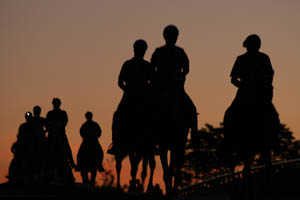  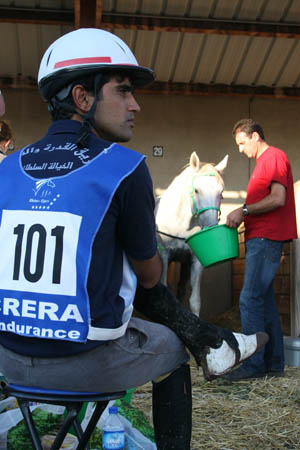      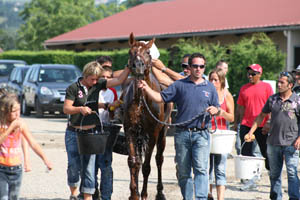  | St Galmier Int'l Cup 164 km – French National Championships Saturday July 14 2007 Lights are on at the Hippodrome de St Galmier by 4:15 AM. Horses are getting tacked, pens for the vet checks are getting set up on the grass, claims are being staked in the crew area with buckets and barrels of water. All loops are out and back into the venue (basecamp), winding over trails and roads through the French countryside. There are 6 loops of 35 km, 30 km, 20 km, 29 km, 30 km, 20km (2 of the loops are repeated), with 40 minute holds at the first 4 vet gates, 50 minutes at the 5th with a compulsory re-examination, and the pulse has to be 64 within 30 minutes of finishing. All riders carry a minimum of 75 kg. Horses were getting saddled, were out being led around to warm up - it was a nice cool morning... but not cool enough for anybody to stiffen up, and not damp like yesterday morning. As it got to be 4:50 AM, horses moved onto the track for the start, circling around; riders calling out, horses whinnying, crews and riders making last minute tack adjustments. I recognized a face from Malaysia – Essa Hamed Al Mannai from Qatar. Amazing for me to recognize anybody with a helmet on in the first place, and in the dark no less! He recognized me at the same time, and we said hi. He was riding with a group of 4 other Qataris, all of whom started together at the back of the pack, and were there to just complete the 160 km ride for the experience, not to race. Also riding among the 22 foreigners were two Omanis, Jamal Al-Baloshi and Saeed Ahmed. Frenchman Denis Letarte trains endurance horses for the Sultanate of Oman and coaches these boys. Oman started endurance 5 years ago, then quit, then started up again a year ago, with Denis training for them. He now spends 7 months a year in Oman, 5 in France. They have 6 of the endurance horses here in France now; Jamal and Saeed were riding two of them, the first 160 km ride for the boys. Jamal used to be a jockey for flat racing until he had a bad injury – he has a few plates in his head - and he doesn't ride flat races anymore. A few years ago a friend said to him, “Come, we are going to do a 20 km endurance race.” Jamal didn't understand. “How can the horses race for 20 km?” But they rode slowly, trotting and cantering, and would stop along the way: “Now we go to the vet check.” “What? What is a vet check?” That was his first mysterious experience with endurance riding – but now he likes it, though he still prefers the speed and excitement and quickness of the flat races. “They are over in 2 minutes, and here you are in the saddle all day!” Herve continued his musical French commentary until the countdown for the start at 5:00 AM: “Cinq – quatre – trois – deux – un – They're off!” (whatever that word is), and 54 riders took off on the blue 35 km loop, out of the stadium into the countryside around Saint Galmier. Motorcycles pre-rode the trail, and a quad ran along right in front of the leader. When there was a big gap, another quad led the next group; and a quad or motorcycle escorts the last horse in off the loops. Nobody wears butt packs with water bottles here because they see their crew on the trail every few kilometers! It was not quite light yet, so some riders wore torches on their helmets. Right after the start, I ran to the van that took our group of photographers and other spectators around the course. I grabbed the front seat, in preparation for the wild and crazy driving to come, but this time, our merry driver was not so wild and crazy, and we didn't follow all the crew cars, instead strategically plotting a course that kept us out of traffic and away from crowds. We stopped on a bridge over a river for our first picture-taking spot; the sun was not yet up but the eastern sky was glowing orange, and framed the silhouette of the riders and horses coming over the bridge. Two riders were far ahead of everybody already, Michel Meunier Carus, clipping along at over 20 km/hr, and Michel Denayer at 19.5 km/hr. Waves of riders came over the bridge; then there was a gap, and then waves and waves of assistance cars came over the bridge! Followed by more horses and cars. After more quiet photo stops away from crew points, we headed back to the venue. Large numbers of riders were already in, or coming in, many of them together, creating the beehive activity in the crew areas cooling down the horses, and lines in the vet check area. On the jaume (yellow) second loop of 30 km, we stopped at the top of a hill for photos. One rider came by and said something in French, which had to be “Smile!” French photographer Yves Riou confirmed it when I asked him. I said “We say 'Cheese!' for photos. What do the French say?” He said “We say 'Cheese!' also. 'Fromage' would just not sound right!” On the 3rd 20 km loop, we drove up behind Yannick Berton, now one of the leaders, who had stopped at a water trough. Photographers Jules and Yves said to the driver, “Stop!” and they jumped out to get Yannick's horse drinking from the trough. But by the time they had gone out, Yannick was leaving, so they called him back. Yannick laughed and gave up a few precious ride seconds to come back and put his horse to the trough for the photographers. We jumped back in the van and followed Yannick down the dirt road, and then we came to a little river crossing, which Yannick took his horse into. We all tried to jump out for the picture, but by the time we got out, Yannick was on his way, and he wasn't turning around this time. No problem, we walked across the bridge and set up on the other side for those great shots of horses plunging into the creek, water spraying everywhere... and here the riders came... and they all took the bridge! Every one of them! We laughed, and took other shots, and were joined by another photographer Brigitte Huard – who'd gotten her car stuck at the other end of the hay-stubble field. As we were talking, Jules yells “Hey!” - there came two riders into the creek! We ran and fired off a few pictures, then watched the rest of the riders go over the bridge. We gave Bridgett a lift to her car, and the 3 big strong men pushed her car as she drove it, out of the field. Alex Luque and his horse Atiklan were looking good, keeping up a 17+ km/h pace. The team of 4 Qataris were still moving steadily along at the back of the field, though Abdullah Towain's horse would vet out lame at the 3rd vet gate. The Omanis Jamal and Saeed were progressing steadily too. Yannick Berton on Menacer was still in the lead by 4 minutes arriving at the 3rd vet gate over Maurice Saint and Michel Carus. Two-time leading FEI World-ranked rider and previous French national champion Jack Begaud, riding Kheopsy Du Pilat was stalking the leaders, ten minutes behind Yannick, with Virginie Atger, second in the 2006 Aachen World Championships, just behind him riding Kaena. Berton was still in the lead by a minute over Schwartz arriving for the 4th vet gate, and they arrived together at the 5th vet gate; but it was Celine's horse that recovered faster, and left on the final 6th loop first. Jack Begaud and Virginie Atger left shortly after in hot pursuit. Fifty minutes later here came the first finishers: Yannick Berton in front by a mere 30 seconds, with Celine Schwartz not racing after him, trotting in across the finish line. Officials would blow a whistle to announce the approach of finishers, to clear the track of spectators and crew, which was a handy thing, because the next finishers, Jack Begaud and Virginie Atger came racing in, with Jack finishing just ahead of her. The top four were busy in the crew area, cooling down their horses, as Jean Luc Riou came in across the line 5th. The top finishers took their horses to trot out for the vets – Celine Schwartz's horse completed, Jack Begaud's completed, both to big cheers... Yannick's horse was questionable! There was a murmuring of dismay from the crowd around the vet ring. The vets had him trot out again, and yes, he was definitely bobbing his head a little. Big groan from the crowd, and still a round of applause – the horse had still run a very fast 160 km race, averaging 18.74 km/hr, and he deserved a big hand for his great effort. Nicolas Vazquez and Marc Couffin also raced in for (now) 5th and 6th. Alex Luque came in on his horse Atiklan in 16th place, completing his horse's first 160 km. Atiklan had lost a shoe on the first loop and the 4th loop, but the shoes were replaced and he continued on down the trail. He looked great trotting out, and Alex and Bernie were elated. The riders continued coming in to the finish – the Omanis were out on their last loop, and the Qataris were just about to go out on their last one – as the Best Condition judging was held, and then the award ceremony for the top 3 finishers. Since Yannick Berton vetted out, Celine Schwartz was the winner – the new French National Champion, with Jack Begaud in second place, and Virginie Atger third... and they were hauled into the arena by pretty donkeys pulling carts! Jack Begaud, the big guy, got the littlest cart. Trophies and medals and flowers were presented to the three, and then the Best Conditioned horse was announced: Jack Begaud's Kheopsy Du Pilat. Jack took him for a trot out around the arena to the cheers of the spectators. The last 4 finishers, the Qatari team, came in together just before 9 PM, concluding the 2007 French National Championships in Saint Galmier. |
Wednesday, July 18, 2007
St Galmier French Nationals - 119 km Ride
      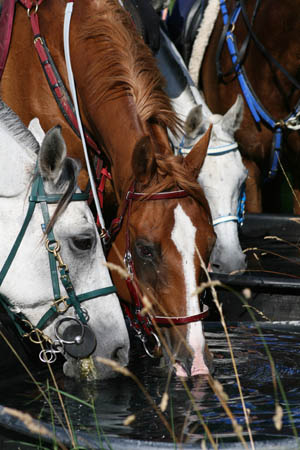  | Wednesday July 13 2007 I got back to France my usual way of travelling: with strangers. Alice arranged for her endurance rider friend Alex Luque to pick me up on a Spanish highway on his way to Saint Galmier near the Provence region in southeast France, for the French National Championships. Jordi Comellas dropped me off at a gas station stop, and Alex and his friend Bernie picked me up at 4 PM, and on the road back to France I went with them. Alex would be riding his gelding Atiklan in the horse's first 160 km ride, and Bernie would be crewing for him. For the second year in a row Saint Galmier was hosting the French National Endurance Championships. In addition to the Bahrain International Trophy 119 km on Thursday, the St Galmier International Cup (Championship of France) 164 km on Saturday, and the CEN* 89 km ride on Sunday, there would also be the Attelage (Driving) Endurance Nationals and the “Championnat de Franc Modeles et Allures Chevaux Pur Sang Arabe” - French National Halter show - going on at the same time in an arena in the infield. A big, busy weekend for horses and riders and drivers and crews and all the many volunteers who worked from morning to night each day! Basecamp, or the venue was the Hippodrome de Saint Galmier, a racetrack where flat and harness racing takes place. There's an inner and middle dirt, and outer grass course. All the horse vans (most of them little 2-horse vans – no live-in trailers) were parked in a big neat row around the inner course. Rows of temporary barns with stalls were put up in one area for the endurance horses; further away another several temporary barns with stalls were put up for the show horses. During the day the horses could be put out on the grass in temporary fencing; at night they went into their stalls. Thursday July 12 2007 I woke up early and caught a ride to the venue (basecamp) in time for the start of the 119 km ride, at a most reasonable hour of 6:30 AM. I got another good taste of the European style of crewing this day – running to the van after the start, racing hell pell mell down the narrow winding roads to crew points and other points where the horses crossed driveable roads. The press van I was in was driven by a very jolly Frenchman who cornered the turns on two wheels with the best of 'em, and Rachel Romezy was along for interpreting when necessary. Following our van, or sometimes leading our van, was another van of camera men from Bahrain TV, following 4 Bahraini riders. Tawfiq Salehi was handing out chocolate bars for breakfast, and had other refreshments – I'm hanging with the Bahrainis from now on! It's crazy at the crew stops again, cars parked on both sides of the tiny one-lane roads, other cars squeezing through the parked cars and people trying to park to get out and get set up – buckets of water and water bottles and people lining the roads and trail, shoes being laced up to prepare for running. When the horses come it's kind of like the baton relay you did in high school: the horse and rider you are crewing for is coming up behind you fast, and you start sprinting till he catches up, and you hand off the water bottle(s) to the rider, who pours and splashes them on her horse at a canter, dropping the bottles when they are empty. You, the crew person, are still sprinting along after the horse, picking up the empty bottles. Sometimes the horses stop for a drink, sometimes they don't. Occasionally a rider has to stop for reshoeing, losing valuable time. After all the horses have passed through and all the crews have packed up to leave and race off to the next crew point, nothing is left behind but footprints of the horses and humans. The horses followed trails through rolling farmland thick with corn and wheat, around the villages of Saint Galmier and Chamboeuf, over a fair amount of paved roads, with traffic control, 1 or 2 humans, at all the crossings. After racing to more crew points on the 30.5 km first loop, we raced back to the venue to watch the action at the first vet gate. It was already a beehive of phrenetic activity, flying sponges and frantic splashing, water bottles pouring and buckets flinging, humans running around the horses and back and forth to the water troughs. Crew people ran to and fro wearing heart rate monitors around their necks or sticking out of their pockets, bridles hanging off shoulders, saddles on arms and backs. It was a cool morning that had started out with heavy clouds (it had rained the last 3 days here), but the clouds were slowly giving way to sunshine. After the 40 minute hold, horses started taking off on their next loop... and we were off in our vans again on the next 29 km loop, zooming along narrow roads in a line of cars, 2-wheeling around roller coaster corners to more stops. The lead horses kept up a fast pace throughout the third 30.5 km loop and the final 29 km loop, with the first three finishers flying home in an exciting galloping finish. Only one second separated the winner Enora Boulenger and her horse Idais Tobiha from second place Celine Schwartz, who finished by one second ahead of Isabelle Boyer. Boulenger had steadily worked her way to the top, from 18th place at the first vet gate, to 6th at the second vet gate, to 1st at the finish. Her horse had pretty amazing recoveries at each vet gate: 37 beats per minute (in 1:29), 62 (in 1:34), 44 (in 3:09), with a pulse of 42 at the finish, and that's with averaging 20 km/hr over the 119 km. Wow. Fourth place Claude Borlet raced in by one second over Magali Zibret. Shaikh Khalid Bin Hamad Al Khalifa finished in 6th place, then later handed the trophy for the officially titled Bahrain International Trophy to Boulenger. In total, 56 of 80 starters finished the ride. Best Conditioned judging was held about an hour after the top ten finished; all the horses entered the ring together, were inspected by veterinarians, and took turns trotting out. Herve Gesdon provided the melodic commentary in French (of which I understood not a word), and as everybody waited to hear the announcement who won, suddenly there was a big groan, and people started leaving the arena. What – nobody won BC? I had to ask what happened. “They will announce the Best Conditioned winner tomorrow!” |
Spain - El Bagual
      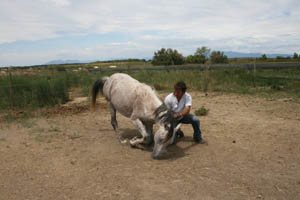  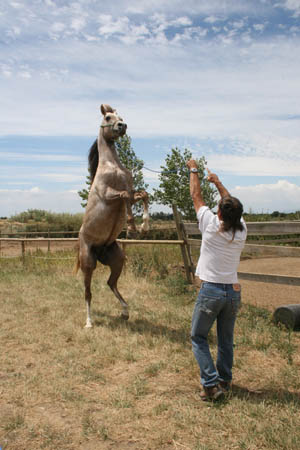 | Tuesday July 10 2007 EL BAGUAL In the morning I met Coby and Jordi in a cafe next door (I had another try at an iced coffee... another tease!). I asked Jordi questions about his horses and his endurance riding through Coby, and he filled in some of the blanks that Coby and I hadn't talked about yesterday. El Bagual, the name of Jordi's little farm, is an old Argentinian word for wild horse breaker – Coby chose the name because it fits with what Jordi does best – taming wild horses. Jordi is one of those Natural Horsemen that have a brilliant way with horses, but doesn't brag about his prowess. Jordi does what he does because he enjoys it, not for show. His business comes by word of mouth, and he has plenty to keep him busy. He's got 5 endurance horses; the rest are stallions, mares and foals, and other clients' horses that need handling or breaking. Jordi Comellas is not a big name in endurance racing, and it's because that's not one of his goals at the moment. His work, his passion, is breaking, schooling, and taming wild horses, and building a strong, slow foundation of work underneath endurance horses. He doesn't like to start ('break') his horses till they are 5 or 6, and he believes very strongly in progressing slowly: much of that training is walking – months, even years, of walking and slow training rides, never racing. With an endurance horse he will do lots of 20 km and 40 km rides, and lots of 60 km rides with a horse before ever considering doing a 90 km or 120 km ride. And he ends up selling the horses before they get to the 120's anyway. Family tragedies interrupted a lot of training last year, but he's back on track with his training and going to endurance rides with his horses. What are Jordi's main goals? I asked Coby. One goal is to put on a 160 km ride in Catalonia because there has never been one here. In France, horses can do 40 km, 80 km, 120 km, and 160 km rides. Some riders in Spain think there is too big a leap in distance between those rides, so here at some rides you can choose to do 20 km, 40 km, 60 km, 90 km, 120 km, or 160 km rides. Many feel that is a better progression for the horses. And, Jordi said in Spanish, and I understood, he really would like to ride Tevis in America! After our coffee, Coby said I'd go off with Jordi for the day while she went about her own business. Oh dear, I thought, with my whole Spanish vocabulary of about 100 words, it is going to make for a silent day. But, off with Jordi I went! And Jordi and I started talking horses during the drive to his farm – and I could not believe it, but I understood him. Either I know a lot more Spanish than I think I do, or, it's the language of horses, (with a little bit of sign language), that makes understanding this foreign language possible. He spoke Spanish to me, not Catalon, (otherwise, forget it!) and he had to speak slowly, and repeat some things, but somehow, I instinctively pulled these words and phrases from somewhere out of the blue, and understood everything he was saying. Jordi's been in this area for 6 yrs but doesn't like it for training – it's too flat, being right by the sea. There were some modest mountains, right there in front of us, but they are off-limits, no horses, no motorbikes. Flat ground doesn't build up a horse's heart. He can haul to mountains further away for serious training when he has to. The walking uphill and downhill builds up their muscles, teaches them to use their whole body. It's also good for their mind, and mental schooling can be as important as physical conditioning. He isn't a fan of the flat racing in the Middle East, either – as far as he can tell, there's no challenge for the rider; you don't have to know your horse at all. Mountain rides are the real endurance rides - a challenge for the horse, the rider, and the two as a team. When we arrived at El Bagual, with its humble sign half hidden behind a raised irrigation canal, and its humble barn (some might say dilapidated or spartan, but I would say antiquated, comfortable, and character-ful), Jordi said, “It's not grand, like Stephan Chazel's or Bernat Casals' place, but it's mine.” The horses looked content, plenty of room to move around, plenty of hay to eat, and that's the important thing. First thing, I got to watch Jordi working with unbroke horses. The first one was a young mare broke to wearing saddle and bridle, and the second was a wilder gelding that had had just a minimum of handling. With both he used ropes, feed sacks, and a plastic bag on a whip to 'sack out' the horses, get them used to standing and accepting the touch and feel and noise. He touched and petted them all over, jumped around then and on them until they relaxed; he used a lunge line, and used driving ropes to get them to move forward, turn, and learn to give to pressure. The key, he says, is to release immediately when the horse responds to pressure. And to know when to stop working with the horse – end on a good note, otherwise there is the risk of hurting the horse, going backward in your training instead of progressing forward. He really prefers best to work with horses who have never been handled – they don't already have any bad habits, taught by humans, that need unlearning first. For each horse, during the work session, after he had it responding well to pressure – moving away from him and coming forward - he took the horse out into the yard and led it over 'Can Alley' – a little path filled with aluminum cans. You can imagine how noisy and scary walking over cans might be for a horse. “Primera vez,” said Jordi – first time for each of them. He led the way and they willingly followed him, walking over the cans, looking at their feet closely, but with a minimum of fright. With the gelding, who was much less broke – Jordi wore gloves out for this one - after time in the round pen and walking over cans, Jordi said he'd try to load him in the 2-horse trailer – only the second time in his life the horse had been in one. The first time was when he was a youngster, and he was driven into one to get to Jordi's place. Using the techniques he'd just used in the round pen – pressure on and instant release when he got a response, driving and releasing, within just a few minutes he got the horse into the trailer. And it was a noisy, scary trailer – it wasn't attached to a vehicle, so the trailer was rocking forward and backward depending on where the horse's weight was centered. Jordi led him out, then back in again; and the second time, the horse walked right in (trailer rocking), and stood there freely, facing forward, and eating hay contentedly. It's like magic watching some of the things good horsemen do when they are working with horses... but it's really just common sense when you think about it. And when it's done right, and it looks like magic, it looks easy... but not everybody can do it! We had planned to go for a ride, but, as happens on horse farms, plans change, and some clients showed up. Jordi saddled a gray horse for the young boy and gave him lessons, while he sent me to fetch and saddle another chestnut horse, Cinnamon – one that did the Hipic Can Vivet ride 2 days ago. I rode around the little farm, then Jordi sent me out on the road on my own. I didn't want to go too far – didn't want the responsibility of taking a stranger's horse out alone! Though you can't tell a whole lot about a horse at just a walk and a short trot, I could still tell that this was an awfully nice horse. Coby had been saying that one of these days, Jordi needs to keep at least one of his good horses and start competing with it in 120 km rides. When I got back, I told them both, “This is the one you need to keep!” And Jordi must have been thinking the same thing... “En Enero (January) noventa kilometros (90 km). En Marzo (March), ciento veinte kilometros! (120 km).” His eyes lit up as he said this, and he repeated this plan to me a couple of times over the day. Jordi got on my horse Cinnamon and led the boy around a bit on the gray horse at a trot; then he demonstrated for all of us Cinnamon's athleticism, loping and galloping, loping and sprinting. He sat well on a horse, looked like a natural part of it. I said, “He looks like the Man from Snowy River!” The Spanish Man from Bahia de Roses – watch for him and Cinnamon on a 120 km ride in Spain in March! |
Monday, July 16, 2007
Roses on the Mediterranean
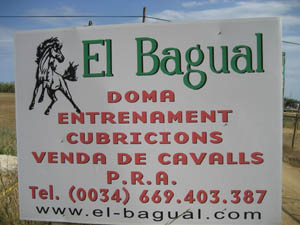    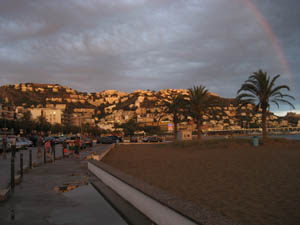    | Monday July 9 2007 In the very northeast corner of Spain, on the Bahia de Roses (Bay of Roses) on the Mediterranean, very near the border with France, is a little unpretentious farm called El Bagual. There are about 2 dozen horses in outdoor electric-fenced pens, a round pen, a couple of horse trailers, and a crumbling antique brick barn with a few stalls, and egg-laying chickens, and one very ecstatic year-old boxer puppy named Grispetta (Popcorn). On the fence boards of this round pen you might see some ropes, lunge lines, carrot stick (you know, the Pat Parelli whip), plastic bag on a whip, and a pair of gloves, and you might see a Spanish endurance rider and natural horseman named Jordi Comellas leading a rather wild-eyed unbroke horse into the pen to work. I'd come to El Bagual in the usual way of my travels, with strangers: Jordi's parents, Ramon and Annamaria, who didn't know me from Adam, picked me up in Berga after Bernat arranged the ride and dropped me off with them (and it was very hard leaving Bernat and Neus, and his parents Valentine and Neus, who made my stay so welcoming and lovely). Jordi's parents didn't speak a word of English, and I quickly exhausted the little Spanish I knew talking with them. We spent most of the ride looking at each other and smiling and giggling. I understood they were taking me to Jordi and his partner Coby's place (Bernat had introduced me to them at the Hipic Can Vivet yesterday)... or somewhere thereabouts. I really wasn't sure exactly where I was going, and I wasn't too worried about it. Somewhere else in Spain to see more horse people was good enough for me! After about 2 hours of driving, Ramon tried to explain something to me, but I wasn't getting all of the words – something about they lived in Vic (which we'd passed through), Coby and Jordi lived in M---, and 1 hour for something, and 10 minutes for something else... but I just didn't have all the words in my Spanish vocabulary to get quite what they were saying. So we just laughed. After about ten minutes we pulled into a “stop” off the highway (gas and restaurant), and there, getting out of another car, was Coby. “OH!” I said, “NOW I know what you were saying!” We all laughed. We all had a drink before getting back on the road, Jordi's parents back to Vic and home, and me with Coby toward Roses. Coby is from the Netherlands, and speaks 7 languages. “How on earth,” I asked, having been a Uno-lingual person all my life, much to my chagrin, “does someone speak SEVEN languages?” Well in the Netherlands, you grow up speaking Dutch, French, and German; and she picked up English, then she went to Italy and learned Italian, and then came to Spain and learned Catalon, and Spanish was not so much more to learn. And she said she enjoyed studying Russian, but she wasn't even counting that as a language. “Besides,” she says, “I like to talk! I just go somewhere and start talking! Jordi sometimes asks me if I EVER shut up! And unfortunately, our kid Joel is taking after me!” She added quite gleefully. On our hour trip to Roses, she talked and talked and answered her phone in between, and had me in stitches with comical stories. We drove from thick green forests down toward the coast, in heavy gray clouds. I hadn't realized how much I'd missed clouds and rain till I was in them. Coby had arranged for a hotel for me in Roses on the bay, and said Jordi would come pick me up in the morning, take me to his farm, talk horses with me... though Jordi did not speak any English. She said she'd be around, in person or by phone, for interpreting. I had a little time at night to walk through the touristy town past many beach clothing stores, restaurants, and gelato places, and the boardwalk along the beach. The sunset was quite spectacular – as most Mediterranean sunsets are – the rain clouds and sun clashing on the horizon and painting the near hills and the far mountains different colors, and of course, there was a rainbow for dessert! The restaurants were crowded, and many people were out walking, late into the night. This strolling about, sitting in restaurants late into the evening is a fine European pastime. Now, I must say a word about European hotels I've encountered so far, in Italy, France, and Spain: NO AIR! No air conditioning, no fans (though the lovely little Hotel Pallotta in Assisi had a fan for me), and sometimes you couldn't open the windows, they were bolted shut! And it wasn't for the crime. Surely it can't be just me who likes, craves, fresh air, cool air. Many of the little villages I've passed through in Spain and France have their shutters tightly closed – it looks like whole towns are empty and abandoned, though you can see a fresh flower pot outside on a balcony, or a few laundry items out to dry, so you know people live there – but shutter windows and doors are tightly closed, all day, into the evenings. Maybe it's against the heat, but even when the sun doesn't hit the windows, whole towns are shuttered. I guess that's what I get – a craving for cool fresh air wherever I go - for spending most of my life working outdoors and the last 10 years living in and appreciating the fresh air of the mountains in summers and deserts in winters! And, the cafe con leche con hielo (coffee with milk with ice) is a TEASE! There's a little tradition, here in Catalonia at least, of this drink – hot strong coffee, with milk if you ask in a cup, served with a glass with ice cubes in it. You stir your sugar (if you want it) into the hot coffee, then dump the hot coffee into the glass with ice. Served properly, (i.e. with enough ice), your coffee becomes cold, and scrumptious (says one who always craves iced drinks). Well. I'd had a great one of these with Bernat's family on the way home after the Hipic Can Vivet ride, and I ordered one of these here in the evening, and I got two, count-em, TWO ice cubes, which promptly melted in the very hot coffee, cooling it off very little. What can you do, but just try to learn to like hot stuffy rooms and not-cold drinks, and laugh! And follow it up with a big serving of gelato. :) |
Tuesday, July 10, 2007
Raid Hipic Can Vivet
       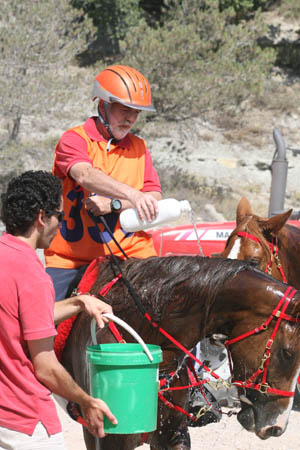    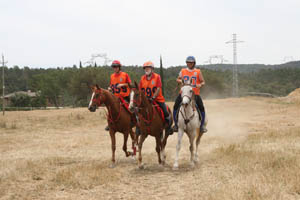 | Sunday July 8 2007 Today I was going along with Bernat and a load of people to a local ride 1 1/2 hours away, the 3rd Raid (Ride) Hipic Can Vivet, at the Club Hipic Centelles, where a 20 km, 40 km, and 60 km were being held. The Casal family (and the three youngsters Bernat was escorting) would ride the 40 km. We were off at 7:38, (“only 8 minutes late!”), and down at the bottom of the hill brother Uri and dad Valentine were merging onto the highway with their van and 2 horses. Bernat's crew, two girls and 2 boys (and Peter, who was one of the riders) followed, and we met up with another carload of people on the way. As we passed through Centelles, and turned off the small road onto the tinier, narrower road, one lane only, leading the 200 metres to the basecamp, which looked packed and chaotic, we met a horse van, 300 crew cars heading out, and another horse van. I was so scared we were going to scrape sides, because there was just no room to pull off the road, I had to employ my Sri Lankan Drive-Calming Technique: look out your side window so you don't see what your driver is going to crash into! Somehow we squeezed by without touching, and, still dodging oncoming crew cars, we pulled into the indeed chaotic ride base. They were trying a new method for this ride: All the distances, 20, 40, and 60 km, could vet in any time between 9 and 10 AM, and could start any time between 9:30 and 10:30 AM. One of the reasons for this, said Bernat, was that too many people tend to run their horses as fast as they can at the beginning, and, since there is a speed limit, usually of around 15 km/hr (you cant' finish faster than this), so many people would pull up short of the finish line and hide and wait for the correct time to finish. And, with so many people racing in a group, more people tended to hurt their horses racing together. Bernat also thought this might be a better situation for teaching young horses; they get used to all the commotion of horses coming and going at all times, so they don't get so hyped up starting in a big group, many of which are acting goofy because they take off so fast. As we pulled in at 9 AM, riders were already going out to start their rides, either alone or in groups; the vet ring was busy with horses vetting in, and cars were racing out of camp for crew points, and people were still arriving with their horse vans. It was like arriving in the middle of an endurance ride – people, horses, cars, coming and going, horses in and out of the vet gate – only it was the beginning of the ride. Bernat parked and his crew unloaded his horses; Uri parked in another area and he and his dad Valentine unloaded theirs. Some of the crew, including mom Neus, took care of the paperwork for all 5 horses (which took quite a while), while the rest of the crew grazed the horses, and set up the saddles and water buckets in the crewing area. Eventually the horse passports returned, and the 5 horses vetted in for the ride. Bernat and the crew saddled them up, and off went Uri and his father Valentine, and shortly after (at 10:12 AM), Bernat (on a gray gelding) and his herd, a young girl (riding a chestnut mare of Bernat's), Peter (one of Bernat's riders, on another chestnut mare of Bernat's), and young Paul (brother of one of the little boys at the Vilaformiu camp, riding his father Salvador's horse). Then it was time to crew! No hanging out and relaxing in basecamp here! Jump in a car with strangers (friends of Salvador's) and race down the narrow winding roads with dozens of other cars, passing by a castle on a hill, to the first crew point in a parking lot, where dozens of other cars were already parked and water bottles and jugs set up. We jumped out and grabbed spots to set up – water containers carried to an open spot and set on the ground, ready to grab and pass off to riders... and then we waited for our riders to come through. This stop must have been at the end of a long hard climb, and most of the riders must have been racing up it, because nearly every horse I saw was panting like a dog when it got to the top. Few of those riders let their horses rest and catch their breaths... they slowed to grab water and dump it on their horses, and they were off again at a trot or canter. When Bernat's group rode up the hill, our crew swarmed onto them with water bottles, and they stopped a while, giving the horses a break, giving them plenty of water to drink, and pouring lots of water on them – it was a very warm day, in the 80's already. Bernat doesn't bring his horses to the shorter distance rides to race – to him they are strictly training rides, to get a horse used to everything – horses in camp, on the trail, at crew points and vet checks. On the trail, Bernat's horses can go, go, go, concentrate on moving forward, but at the crew points is where the horse can relax, physically and mentally, catch his breath, drink, eat grass, and not worry about catching other horses that are coming into or going out of the crew points. Back on the trail, it's all business – and easier because the horse has learned to take a little break. Once the Casal gang moved back out onto the trail (road), our 3 cars of people refilled water jugs, loaded them back in the cars, jumped in, and raced (!) down the winding roads to the next stop – not too far away by car, but plenty of kilometers by trail, because once we were set up, we waited a while for them to appear again. And here they came in a group, trotting down the paved road, stopping for a good drink and dousing with water – some of the riders dousing themselves too, because it was warm for everybody. Bernat's group was toward the back of all the riders, so while we were waiting to crew, and crewing, there were always other crews packing up and leaving, and other cars driving by, and motorcycles, and quads, and bicyclists passing. When our riders left, here we go again, packing up, jumping back in the car, and racing back along the narrow winding roads, underneath the castle, back to camp to wait for our riders to come in off the first loop. We had plenty of time to get there before the horses, but I'm beginning to think that RACING along in your car is part of the fun. Base camp was really lively now, horses of all distance coming and going, vets in the ring very busy, water flying everywhere to cool horses and people down, cars racing in and out of camp, cars trying to drive through the busy crewing areas so they could get on the road and race to their riders' next crew points. The barbecue man was busy, as was the stand selling sandwiches, cool soft drinks and water and beer on tap. Our horses vetted through fine, and had a 50 minute hold. Valentine told me, “I think the horse is better than me!” as he hobbled by with his horse. There was a good breeze blowing through camp, which saved everybody from baking. Once they resaddled and we sent them off on the trail again, here we went again, jumping in our cars and racing to the next crew point with dozens of other cars, the narrower the road (1-lane) the better, the windier the road the better, the faster the driving the better, the dustier the roads the better! Sitting in the back seat was like a roller coaster ride, wheeee! We got set up at the crew stop, and waited, and waited, every car passing us kicking up a fine breath of dust that continuously settled over everything. Our horses and riders came through, looking hot (the riders moreso, maybe), and they took a good water break here. Then we loaded up everything, jumped back into the car, and raced back to basecamp – that was our last crew point. In camp we waited quite a while for our riders to come in and finish. First across came Paul, Peter, and the young girl, and a few minutes later, Valentine and his two sons Bernat and Uri came across the line. Valentine had wanted to race in, but Bernat told him, "No way! You won't be able to stop your horse!" Bernat and Uri let dad cross the line first. Valentine slowly slithered off his horse, held by his crew, landed gingerly on the ground, then hobbled after his horse. He showed me a wounded ankle – his horse had slipped in a hole on a narrow part of the trail, fallen down, and pitched Valentine to the ground, then stepped on him. Ouch! But, being an endurance rider, he got back on, and finished the race – with a smile on his face I might add. (Back home at night, he found his side injured also, and he went to the hospital for a check and a tetanus shot.) Bernat was very pleased with all his horses, and he spent the drive home – and much of the rest of the evening, reflecting on his horses' performances, what might be next for them, what he might have done better for them, and what he might try next time. Bernat enjoys competing in the longer rides, but he also enjoys these local training rides - partly because he enjoys the training and schooling of the horses, and partly because he knows everybody! Everywhere he waved to people, said hello, stopped and talked to them. Every van we passed on the road he honked at and told me who they were. It was one big endurance family getting together and having a good day's ride - great way to spend a Sunday in Spain! |
Subscribe to:
Comments (Atom)